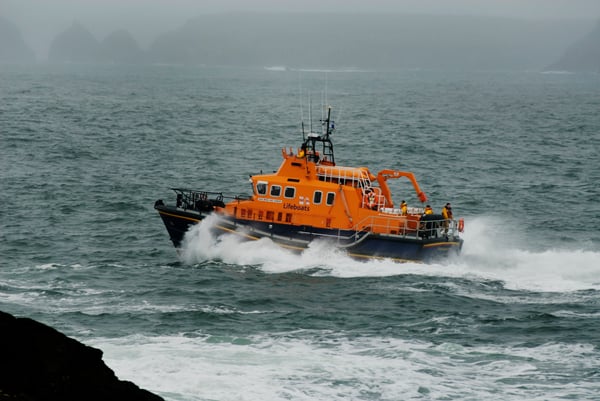Two young fishermen are recovering today (Sunday 31 October 2010) after being rescued by lifeboat crew from Ballyglass RNLI. The two men were found in a liferaft 13 miles north of Belderrig in County Mayo after a lifeboat crewmember raised the alarm when they had not returned after to shore last night. Their fishing vessel had capsized and unable to raise the alarm the two men spent ten hours at sea in a liferaft waiting for help.
Ballyglass RNLI volunteer crewmember John Walsh contacted the Ballyglass Lifeboat Operations Manager when a fishing vessel had not returned to Porturlin when expected. Lifeboat Operations Manager Harry McCallum got in touch with Malin Head Coast Guard and the Ballyglass RNLI all weather lifeboat was launched at 11.49pm along with the Sligo based Coast Guard helicopter.
The rescue crews headed to the area where the fishermen were understood to be recovering pots from the water. The helicopter crew spotted the liferaft with the two men onboard and communicated the position to the lifeboat, which was nearby. The men had managed to remove their wet clothes and had put on plastic sacks to keep warm. They were recovered onto the lifeboat and taken to Ballyglass to recover.
Commenting on the callout Ballyglass RNLI Coxswain JT Gaughran said, " These two young men were extremely lucky. There had been nobody out searching for them until our crewmember John Walsh, who is an experienced fisherman, raised the alarm. Things can go wrong very quickly out at sea and every second counts. Thankfully conditions were moderate and once the search was underway they were spotted quickly."
The lifeboat pictured below returned to Ballyglass at 3am this morning with the two men onboard.

Related Safety posts
RNLI Lifeboats in Ireland
Safety News
Rescue News from RNLI Lifeboats in Ireland
Coast Guard News from Ireland
Water Safety News from Ireland
Marine Casualty Investigation Board News
Marine Warnings































































